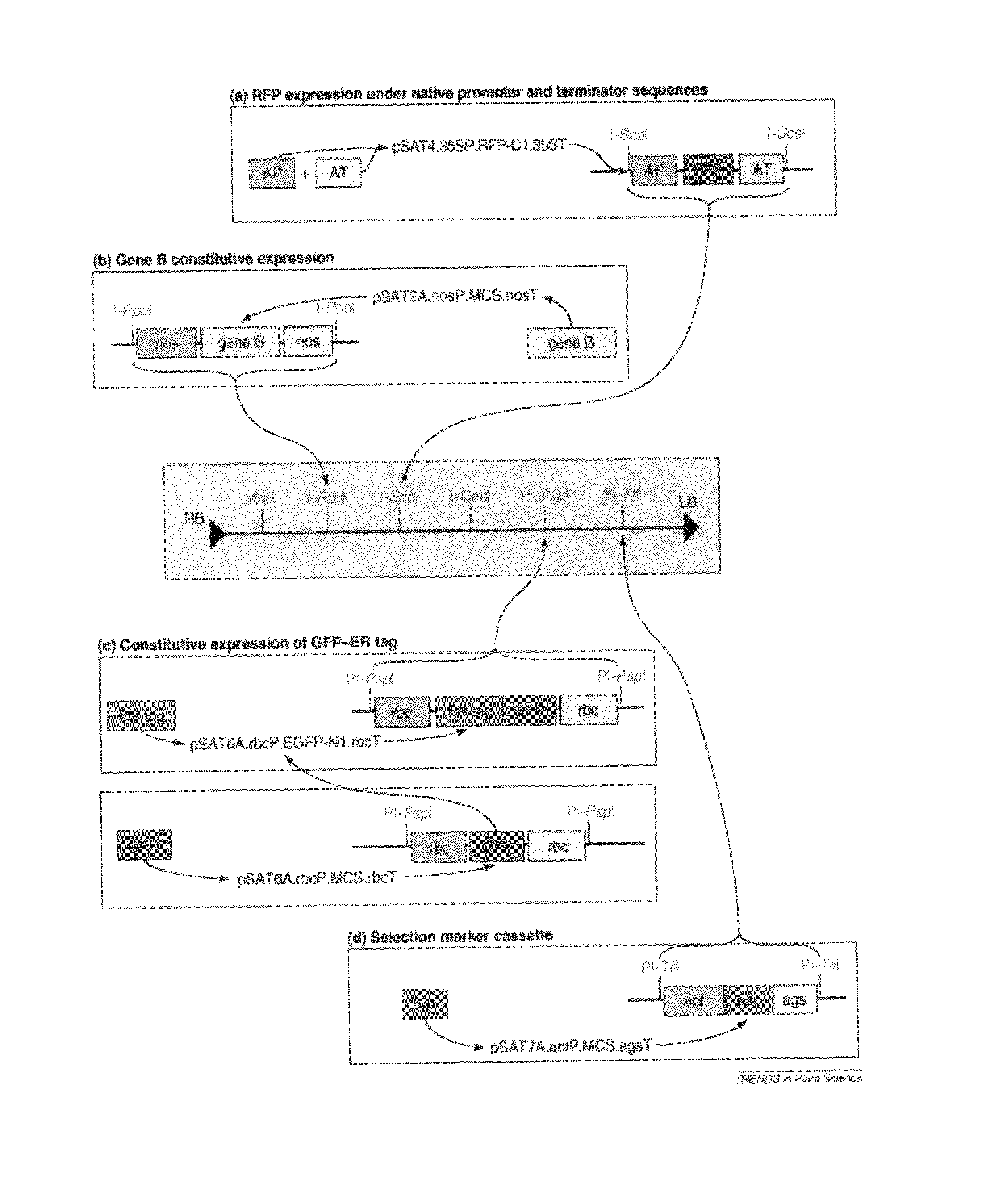Transgenic cover plants containing hemicellulase and cellulase which degrade lignin and cellulose to fermentable sugars
a technology of hemicellulase and cellulase, which is applied in the field of transgenic monocot plants, can solve the problems of only successful processes, untapped sources of energy, and most of the energy potential of biomass gone unused, so as to reduce soil erosion, prolong active nutrient uptake season, and reduce water loss
- Summary
- Abstract
- Description
- Claims
- Application Information
AI Technical Summary
Benefits of technology
Problems solved by technology
Method used
Image
Examples
example 1
[0092] This example shows the construction of plasmids comprising a heterologous gene expression cassette comprising a DNA encoding a cellulase fusion protein and a heterologous gene expression cassette comprising a DNA encoding the bar gene (Table 1).
TABLE 1ConstructPlasmid features1rbcSP / e1 / pin 3′ / / Act1 P / bar / nosrbcSP leaf-specific promoter3′driving cellulase cDNA of A.2rbcSP / cbh1 / pin 3′ / / Act1rbcSP leaf-specific promoterP / bar / nos 3′driving cellulase cDNA of T.3rbcSP / rbcS SP / e1 / pin 3′ / / Act1The rbcS SP targets cellulaseP / bar / nos 3′of A. cellulolyticus intomaize chloroplasts4rbcSP / rbcS SP / cbh1 / pin 3′ / / Act1The rbcS SP targets cellulaseP / bar / nos 3′of T. reesi into maizechloroplasts
Abbreviations:
[0093] The term “rbcSP” means the rice rubisco rbcS promoter region. The rbcSP is a leaf-specific promoter that limits transcription of rbcS to the leaves (25Schaeffer and Sheen, Plant Cell 3: 997-1012 (1991)). The nucleotide sequence for the rbcS promoter region is set forth in SEQ ID NO:1....
example 2
[0117] This example shows the construction of plasmids comprising a heterologous gene expression cassette comprising a DNA encoding a cellulase fusion protein. The plasmid constructs are shown in Table 2.
TABLE 2ConstructPlasmid features1rbcSP / cbh1 / pin 3′rbcSP leaf-specificpromoter driving cellulasecDNA of T. reesei2rbcSP / rbcS SP / cbh1 / pin 3′The rbcS SP targetscellulase of T. reesi intomaize chloroplasts3rbcSP / rbcS SP / syn-cbh1 / pin 3′The rbcS SP targetsmodified cellulase of T,reesei into maizechloroplasts4CaMv35s / SSU / e1 / nos3′The SSU targets thecellulase of A.cellulolyticus into maizechloroplasts5CaMv35s / VSP / e1 / nos3′The VSP targets thecellulase of A.cellulolyticus into maizeapoplasts6CaMv35s / e1 / nos3′No signal peptide
Abbreviations:
[0118] The term “syn-cbh1” refers to a cbh1 gene that has been codon-modified for use in transformation of tobacco plants.
[0119] The term “CaMV35s” refers to the cauliflower mosaic virus promoter.
[0120] The term “SSU” refers to the glycine max rbcS signal...
example 3
[0138] This example shows the construction of plasmids comprising a heterologous gene expression cassette comprising a DNA encoding a ligninase fusion protein and a heterologous gene expression cassette comprising a DNA encoding the bar gene. The constructs are shown in Table 3.
TABLE 3ConstructPlasmid features1rbcSP / ckg4 / pin 3′ / / Act1rbcSP leaf-specificP / bar / nos 3′promoter driving ckg4 cDNAof P. chrysosporium2rbcSP / ckg5 / pin 3′ / / Act1rbcSP leaf-specificP / bar / nos 3′promoter driving ckg5 cDNAof P. chrysosporium3rbcSP / rbcS SP / ckg4 / pin 3′ / / Act1The rbcS SP targets ckg4P / bar / nos 3′into maize chloroplasts4rbcSP / rbcS SP / ckg5 / pin 3′ / / Act1The rbcS SP targets ckg5P / bar / nos 3′into maize chloroplasts
Abbreviations:
[0139] The terms “ckg4” and “ckg5” mean the ligninase cDNAs isolated from the basidiomycete Phanerochaete. chrysosporium, SEQ ID NO:11 and SEQ ID NO:13, respectively. The codons for the 28 amino acid leader are deleted so that the expressed gene product remains inside the cells.
[0140]...
PUM
| Property | Measurement | Unit |
|---|---|---|
| digestibility | aaaaa | aaaaa |
| MW | aaaaa | aaaaa |
| temperature | aaaaa | aaaaa |
Abstract
Description
Claims
Application Information
 Login to View More
Login to View More - R&D
- Intellectual Property
- Life Sciences
- Materials
- Tech Scout
- Unparalleled Data Quality
- Higher Quality Content
- 60% Fewer Hallucinations
Browse by: Latest US Patents, China's latest patents, Technical Efficacy Thesaurus, Application Domain, Technology Topic, Popular Technical Reports.
© 2025 PatSnap. All rights reserved.Legal|Privacy policy|Modern Slavery Act Transparency Statement|Sitemap|About US| Contact US: help@patsnap.com



